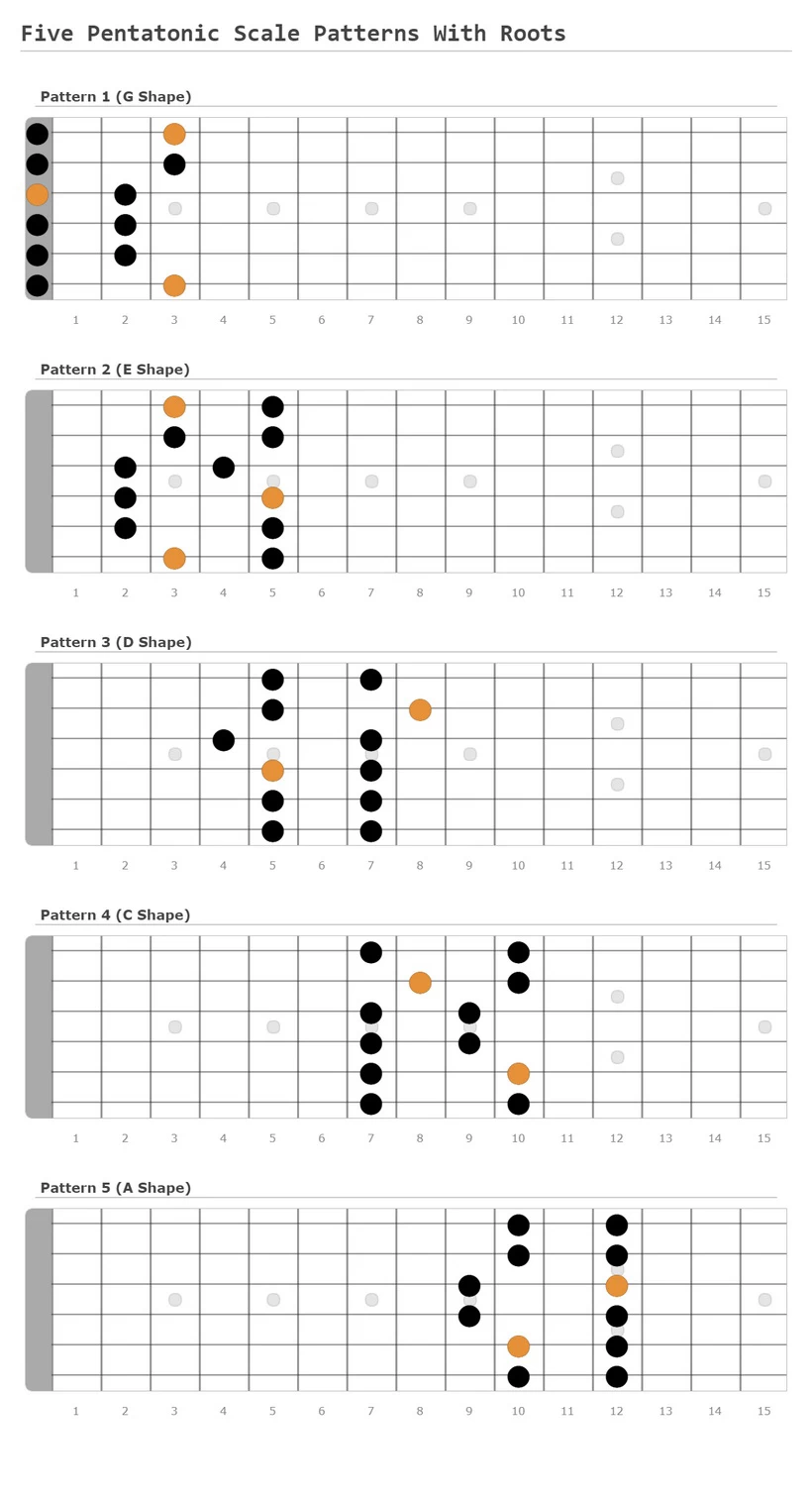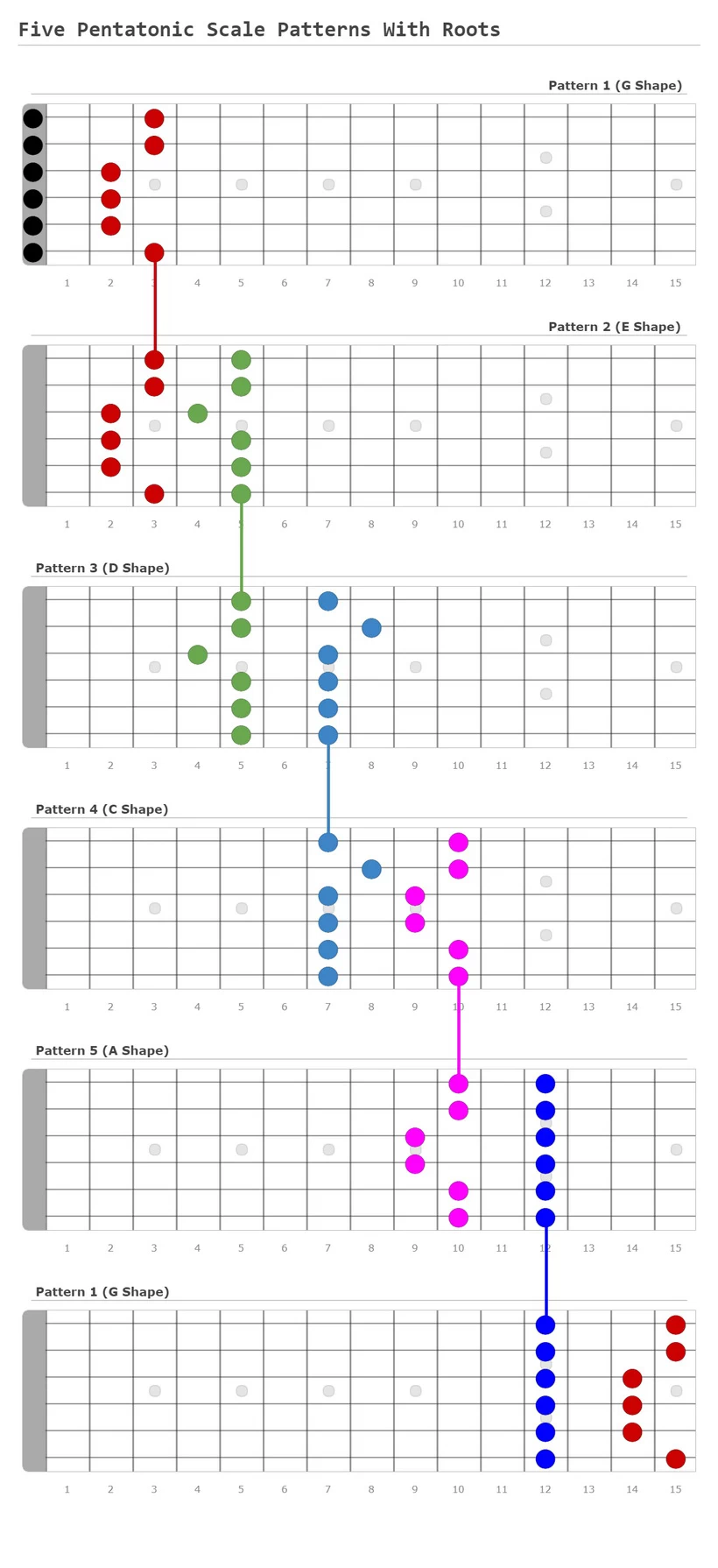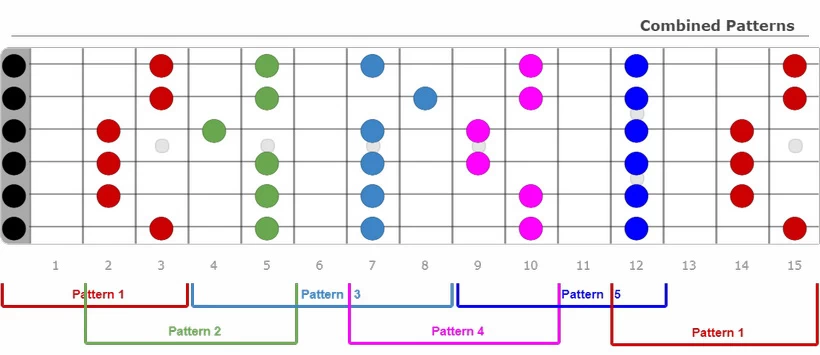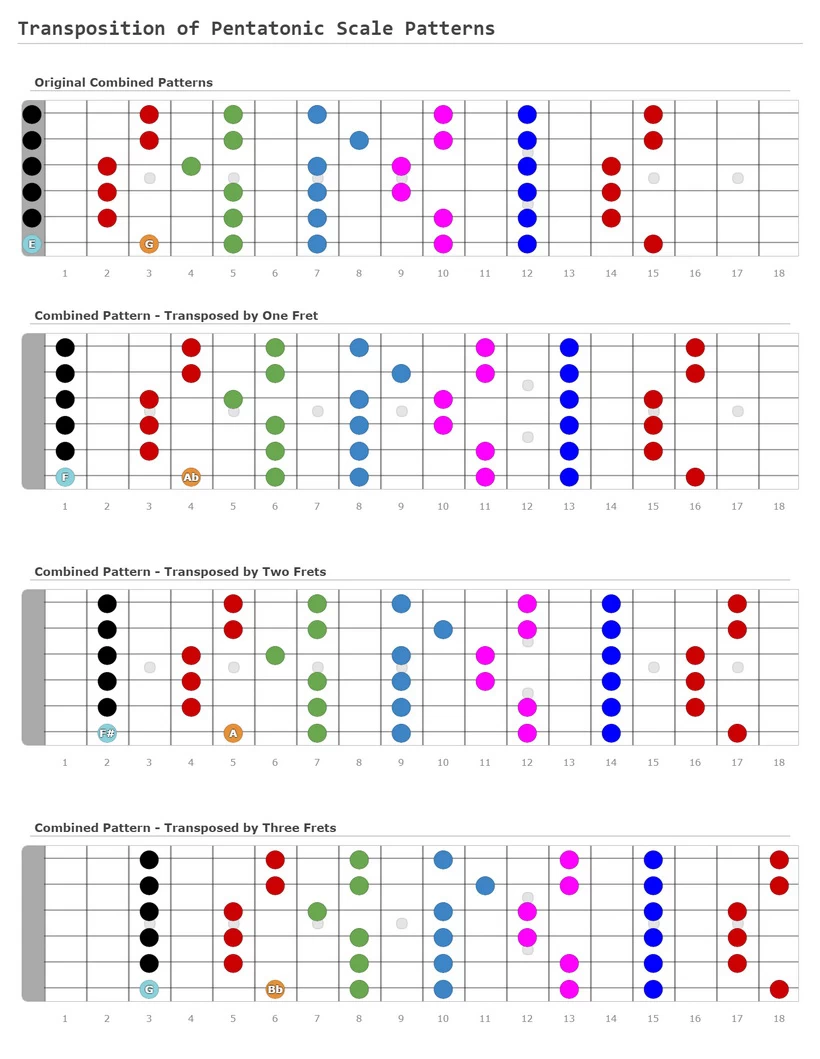Interested in learning the Pentatonic Scale?
The Pentatonic Scale is a five-note scale that is widely used in music. It can be found in all styles of music and is one of the most commonly used scales in modern music.
There are many ways to use the pentatonic scale, including the five scale templates known as box patterns, and with a little practice, you can master this scale and play it in any key. In this article, we will explore the pentatonic scale, its history, and how to use it in your own music.
Read the full article below to learn more about the Pentatonic Scale!
What is the Pentatonic scale?
The literal meaning of the word pentatonic is “five per octave.” Hence they are five-note musical scales, as against seven notes in any heptatonic scale, like the diatonic scale. As per this definition, any scale with five notes will qualify as pentatonic.
Various scales in different parts of the world meet this requirement. However, Western music commonly uses a particular structure with two variations known as the minor pentatonic and the major pentatonic scales.
History of Pentatonic Scale
The use of the pentatonic scale predates recorded musical history. Flutes made from vulture bones and tuned to the pentatonic scale have been found in Germany that date back at least 30,000 years. These scales have been used in Indian, Chinese, Japanese, and African music extensively.
Currently, the minor pentatonic scale forms the foundation of most blues and rock music. It is also used in all the genres like rock ‘n’ roll, pop music, country, bluegrass, R&B, heavy metal, folk, etc., that spanned from the blues.
Pentatonic Scale Music Theory
In addition to major and minor, another popular classification of the pentatonic scale is anhemitonic or hemitonic. An anhemitonic scale does not carry any semitone interval, while hemitonic scales have one or more semitones.
Due to the presence of half-step intervals in hemitonic versions, the other steps of the scale have to be large, leading to ditonic (two whole-tone or four semitone or a major third) intervals. An example of the hemitonic scale is the Japanese scale with the notes C, D, Eb, G, Ab, C. Note the ditonic intervals between notes Eb & G and Ab & C.
The pentatonic scales in western music are anhemitonic scales that do not carry a half-step or ditone interval. Also, the half-step or minor 2nd intervals are dissonant intervals that create. They create tension that needs to be resolved, like between scale degrees 4 & 3 and 7 and 1(8) of all major scales.
Types and Structure of Pentatonic Scales
With this background, you can now go through the structure, intervals, notes, modes, and chords of the two pentatonic scales. Let us start with the major pentatonic scale.
Major Pentatonic Scale
The structure of the major pentatonic scale is given by the detailed representation.
R – T – M2 – T – M3 – TS – P5 – T – M6 – TS – R, where,
TS = 3 semitones, which is a combination of a tone and semitone. It is equal to an interval of a minor third from the first note of the interval.
As you know, the scale formula represents the unique set of intervals in any scale. You can derive the following scale formulas for this scale from the scale representation given above as
{W, W, WH, W, WH} in terms of the whole and half steps, and
{T, T, TS, T, TS} in terms of whole and semitones.
Intervals & Notes of Major Pentatonic Scale
Again using the structural representation, the intervals of any major pentatonic scale from the root note are R – M2 – M3 – P5 – M6 – R(O), where R(O) is the root note octave above.
Hence the notes of the C major pentatonic scale are [C, D, E, G, A]. the table below gives the notes of all the major pentatonic scales with the 12 chromatic notes as their root.
| Tonic | Note 1 | Note 2 | Note 3 | Note 4 | Note 5 | Note 1(6) |
|---|---|---|---|---|---|---|
| Intervals | R | T | T | TS | T | TS |
| C | C | D | E | G | A | C |
| C# | C# | D# | F | G# | A# | C# |
| D | D | E | F# | A | B | D |
| D# | D# | F | G | A# | C | D# |
| E | E | F# | G# | B | C# | E |
| F | F | G | A | C | D | F |
| F# | F# | G# | A# | C# | D# | F# |
| G | G | A | B | D | E | G |
| G# | G# | A# | C | D# | F | G# |
| A | A | B | C# | E | F# | A |
| A# | A# | C | D | F | G | A# |
| B | B | C# | D# | F# | G# | B |
In a way, the major pentatonic scale can be considered to be a major scale with gaps. You can construct it in two ways.
- Pick the five consecutive notes from the circle of fifths. For example, C, G, D, A, and E. Find an anhemitonic mode such that all the notes are in one octave with intervals of T and TS only. You will get the notes of the major pentatonic scale.
- In the second method, omit two pitches, the Perfect 4th and Major 7th, from the corresponding diatonic seven-note scale. For example, if we omit the Perfect 4th (F) and Major 7th (B) from the C major scale {C, D, E, F, G, A, B}, we get C major pentatonic {C, D, E, G, A}
Minor Pentatonic Scale
The minor pentatonic scale is a relative minor of a major pentatonic scale. You will be aware of the relative majors and minors from your knowledge of the major and minor scales, which carry the same notes. The same concept is applicable to the pentatonic scales also, where each major pentatonic scale has a relative minor and vice versa.
The detailed representation of the structure of any minor pentatonic scale is
R – TS – m3 – T – P4 – T – P5 – TS – m7 – T – R, leading to the scale formulas
{WH, W, W, WH, W} in terms of the whole and half steps, and
{TS, T, T, TS, T} in terms of whole and semitones.
Like the major pentatonic scale, you can derive the intervals of any minor pentatonic scale from the root note from the detailed representation. They are R – m3 – P4 – P5 – m7 – R(O), where R(O) is the root note one octave above.
Hence the notes of the A minor pentatonic scale are [A, C, D, E, G]. As you can see, they are the same notes as that of the C major pentatonic. Hence, A minor is the relative key of the C major pentatonic scale. You can also derive the notes of any minor pentatonic scale from the {1, 3, 4, 5, 7} scale degrees of the natural minor scale.
The table below gives the notes of all the major pentatonic scales with the 12 notes as their root.
Minor Pentatonic Scale Notes
| Tonic | Note 1 | Note 2 | Note 3 | Note 4 | Note 5 | Note 1(6) |
|---|---|---|---|---|---|---|
| Intervals | R | TS | T | T | TS | T |
| C | C | Eb | F | G | Bb | C |
| C# | C# | E | F# | G# | B | C# |
| D | D | F | G | A | C | D |
| D# | D# | F# | G# | A# | C# | D# |
| E | E | G | A | B | D | E |
| F | F | Ab | Bb | C | Eb | F |
| F# | F# | A | B | C# | E | F# |
| G | G | Bb | C | D | F | G |
| G# | G# | B | C# | D# | F# | G# |
| A | A | C | D | E | G | A |
| A# | Bb | Db | Eb | F | Ab | Bb |
| B | B | Db | E | F# | A | B |
Some other observations about the pentatonic scales are:
- The major pentatonic scale is the 2nd mode of the minor pentatonic scale, and the minor version is the 5th mode of the major pentatonic.
- Minor pentatonic can be considered as the gapped blues scale.
- The standard guitar tuning corresponds to the notes of the E minor pentatonic scale {E A D G B E}.
Modes of Major Pentatonic Scale
Similar to the diatonic modes, you can find out the modes of the pentatonic scales by starting with different scale degrees as the tonic notes and keeping the sequence of the notes the same. In the major key of C, the five modes will start with the notes C, D, E, G, and A.
It is important to note that pentatonic scales have only five notes, with the two notes omitted from the respective diatonic scale. Hence, each mode of the major pentatonic scale will correspond to three modes of diatonic scales. The five modes are major, blues major, suspended, minor, and blues minor scales. The details are shown in the table below.
| Tonic Note | Pentatonic Mode | Diatonic Scale Modes | Base scale Degrees | Changes | Intervals |
|---|---|---|---|---|---|
| C | Major | Lydian Mode, Ionian Mode, Mixolydian Mode | I–II–III–V–VI | Delete 4 7 | T-T-TS-T-TS |
| D | Suspended | Mixolydian Mode, Dorian Mode, Aeolian Mode | I–II–IV–V–VII | Delete 3 6 | T-TS-T-TS-T |
| E | Blues Minor | Aeolian Mode, Phrygian Mode, Locrian Mode | I–III–IV–VI–VII | Delete 2 5 | TS-T-TS-T-T |
| G | Blues Major | Ionian Mode, Mixolydian Mode, Dorian Mode | I–II–IV–V–VI | Delete 3 7 | T-TS-T-T-TS |
| A | Minor | Dorian Mode, Aeolian Mode, Phrygian Mode | I–III–IV–V–VII | Delete 2 6 | TS-T-T-TS-T |
Intervals of Pentatonic Modes from Tonic
As clarified above, each mode is a scale by itself and has different sets of intervals defining it. The intervals between the notes of these modes are shown in the table below.
| Tonic Note | Pentatonic Mode | Root | 2nd Note | 3rd Note | 4th Note | 5th Note | Octave |
|---|---|---|---|---|---|---|---|
| C | Major | P1 | M2 | M3 | P5 | M6 | P8 |
| D | Suspended | P1 | M2 | P4 | P5 | m7 | P8 |
| E | Blues Minor | P1 | m3 | P4 | m6 | m7 | P8 |
| G | Blues Major | P1 | M2 | P4 | P5 | M6 | P8 |
| A | Minor | P1 | m3 | P4 | P5 | m7 | P8 |
Harmonisation of the Pentatonic Scales
It is very usual to play the diatonic chords over the pentatonic scales. As you know, the diatonic chords are not formed from these scales and carry two additional notes omitted from the pentatonic scales.
The harmonization of these scales using the 1st, 3rd, and 5th notes results in pentatonic chords without any extra notes.
The chords that result from diatonic scales are major, minor, and diminished chords. But from pentatonic scales, you will get the inversions of the diatonic minor chord, suspended, and major chords. These chords are formed by stacking Major third (M3) and Perfect fourth (P4) intervals instead of thirds in the diatonic triads. The table below shows the stacking intervals, notes, intervals from the root, and the type of resulting diatonic chord inversion.
| Stacking Intervals | Chord Notes | Chord | Root | 3rd Note | 5th Note | Inversion |
|---|---|---|---|---|---|---|
| M3 - P4 | D-F#-B | Bm/D | P1 | M3 | M6 | Minor |
| P4 - M3 | C-F-A | F/C | P1 | P4 | M6 | Major |
| P4 - P4 | C-F-A# | Fsus4/C | P1 | P4 | m7 | Suspended |
| P4 - P4 | D-G-C | Gsus4/D | P1 | P4 | m7 | Suspended |
By use of chromatic notes and augmenting, diminishing the intervals above, you can get the inversions of the augmented and diminished intervals, as shown in the table below.
| Stacking Intervals | Root | 3rd Note | 5th Note | Inversion |
|---|---|---|---|---|
| M3 - M3 | P1 | M3 | m6 | Augmented |
| m3 - A4 | P1 | m3 | M6 | Diminished |
| A4 - m3 | P1 | Tritone | M6 | Diminished |
What Is the Pentatonic Scale Used For In Music?
The pentatonic scales are good for any mainstream genre except classical music, opera, or jazz music that isn’t based on blues. They are specifically used in
- Lead guitar for country music,
- In Blues music, with an added b5.
- In heavy metal by the shredding lead guitarists.
- In pop, R&B, etc.
Songs Based on the Pentatonic Scales
The below list includes the songs, riffs, etc., that make use of the pentatonic scales.
- “Amazing Grace” – G Major Pentatonic Scale.
- “Are You Gonna Go My Way” – Lenny Kravitz – E Minor Pentatonic scale.
- “Stairway to Heaven” – Led Zeppelin – A Minor Pentatonic scale.
- “Paranoid” – Black Sabbath – E minor Pentatonic.
- “Yellow Ledbetter” – Pearl Jam (Solo) – E Major Pentatonic.
- “Another Brick In The Wall, Pt. 2″ – Pink Floyd – D Minor Pentatonic.
- “American Woman” – Lenny Kravitz – C Minor Pentatonic scale.
Major Pentatonic Scale Positions on the Guitar
In our article on CAGED guitar patterns, we informed you that the best way to learn any scale on guitar and, for that matter, all string instruments is to divide it into easy-to-learn and play patterns or shapes. This is further aided by matching these shapes with some known ones and finally connecting all these shapes across the entire fretboard.
The following section gives five such patterns known as the pentatonic box patterns. We urge you to memorize these patterns like you memorized the notes on the fretboard. We would always recommend that you focus on these patterns and be thorough with them instead of focusing on the positions of notes of the scales and chords in individual keys.
5 Pentatonic Scale Patterns
Let us briefly introduce you to these five box patterns. Before reading through the details of the individual box pattern, you can study them in the diagrams first.

Pattern or Box 1
The first pattern is known as the G-shape pattern and has three root notes organized in a triangular shape. In the current position of the pattern, the lowest root is found on the 3rd fret of the 6th string. If you carefully observe the shape, you will note that you can build an Em and G major chord from this pentatonic scale shape. You cannot make any other basic chord shape.
In this position, the scale can act as an E minor Pentatonic scale or G major Pentatonic scale. The first note on the 6th string will always be your minor root, and the second note will be your major root. We will see in later sections how to transpose the pattern to get other major and minor pentatonic scales.
Pattern or Box 2
The 2nd pattern, like the 1st one, has three root notes in the triangular shape on the 1st, 4th and 6th strings. Learning the root note positions is an absolute must and even helps recognize a particular pattern. The lowest root note is on the 6th string. It
This pattern is known as the E shape pattern and is always known as pattern 2, regardless of its position on the fretboard. The pattern carries the E major and D minor chords.
Pattern 3 or Box 3
The 3rd pattern, also known as the D-shaped pattern and has two root notes on the 4th and 2nd strings. This is the only pentatonic pattern that stretches to five frets instead of four. This pattern carries the D major and C minor chords. The C minor is not available in the open position and has a little awkward form.
Pattern 4 or Box 4
4th pattern, known as the C pattern, has two roots on the 5th as well as the 2nd strings. The pattern carries the A minor and C Major chords.
Pattern 5 or Box 5
the last pattern is known as the A pattern with the two roots on the 3rd and the 5th strings. As you can understand by now, the pattern carries the G minor and A major chords. Like the Cm chord, the Dm is also not available in the open position.
Observe the below table, which gives the minor and major chords associated with each pattern.
| Pattern No. | Major Chords | Minor Chords |
|---|---|---|
| Pattern 1 | G Major | E minor |
| Pattern 2 | E Major | D minor |
| Pattern 3 | D Major | C Minor |
| Pattern 4 | C Major | A Minor |
| Pattern 5 | A Major | G Minor |
You can see CAGED (C, A, G, E, D) chords in both major and minor forms in these patterns. Hence, you can convert all the open CAGED forms into minor forms and use them if you want. In the balance article, we will continue with the major CAGED form.
Fingering the Patterns
There are many options with regard to fingering the above box patterns that make up the pentatonic scale template. It is easier to finger pentatonic scales in comparison to any diatonic scale, as you have only two frets per string to finger for all the patterns.
Hence many guitar players tend to use only their index and middle fingers to have better control, generate more power, and avoid the entanglements between adjacent fingers.
Our recommendation is always to follow the one-finger per fret rule. As four out of the five patterns are spread over only four frets, you can easily designate one finger for each fret and play. It is easier to visualize the patterns with this approach. If you become comfortable with this style, you don’t have to change much going for major or minor scales.
Connecting the Scale Patterns
If you carefully observe the five pentatonic box patterns, you will note that a part of each pattern is reused in the next pattern. This allows easy connectivity between the patterns. The diagram below shows notes on each pattern in different colors and their connection to the subsequent pattern.

You can see that box pattern 1 connects to pattern 2, pattern to pattern 3, and so on till pattern 5. Pattern 5 again connects back to pattern 1 an octave higher, and the process repeats till you run out of frets.
Of course, it is not easy to finger beyond the octave due to the reduction in the distance between frets. The issue further gets aggravated for acoustic guitars without the cutaways, and you may curve your fingers to play or give up before reaching the end of the fretboard.
If you transpose the entire connected template to fret 3, you can place pattern 5 before it. The process continues till you are out of frets in the open position or the body side.

Transposing to Another Key
Carefully observe box pattern 1, wherein there are six notes in the open position. The open E on the 6th string is the minor root, and the note on the 3rd fret of the 6th string is the major root G.
You can shift the entire scale shapes template by one fret so that it starts now on the 1st fret instead of the open position. The shifting has transposed the E minor pentatonic and G Major pentatonic scales to new keys. Note that the minor and major roots have shifted to the 1st and 4th fret on the 6th string, and the new keys are now F minor and Ab Major.
Further shifting by one more fret to fret 2 gives A Major and F# minor pentatonic scales, and so on.

How to practice the Pentatonic Scale
It is always to memorize and master one pattern at a time till you are very comfortable with it. Move on to the adjacent pattern and repeat the process. Next, work on the connection between these two patterns and their transitions.
Repeat the process till you have exhausted all the patterns and their connections.
Conclusion
A Pentatonic scale is a versatile tool every guitarist should have in their arsenal. There are many different ways to use the pentatonic scale, and it can be used in any style of music. I hope this article has helped you understand what the pentatonic scale is and how to use it in your playing. Let me know in the comments section if you want any clarifications.

